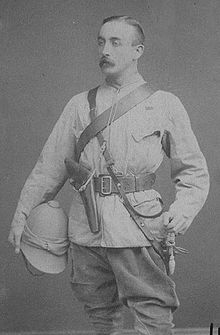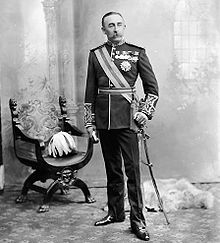Gilbert Elliot-Murray-Kynynmound, 4th Earl of Minto
Gilbert John Elliot-Murray-Kynynmound, 4th Earl of Minto KG GCSI GCMG GCIE PC (born July 9, 1845 in London , † March 1, 1914 in Minto , Roxburgh , Scotland ) was a British officer and statesman who was not only Governor General of Canada and Viceroy of India but was also Rector of the University of Edinburgh .
biography
Promotion to Governor General of Canada
He was the eldest son of William Elliot-Murray-Kynynmound, 3rd Earl of Minto . As his apparently marriage he carried the courtesy title Viscount Melgund from 1859 to 1891 .
He attended Eton College and completed studies at the Trinity College of Cambridge University from.
He then joined the British Army and initially served from 1867 to 1870 as a lieutenant in the Scots Fusilier Guards . In 1872 he became captain of the 1st Roxburghshire Mounted Rifle Volunteer Corps . In 1877 he took part in the Russo-Ottoman War as a volunteer in the Ottoman Army . In 1878 he was ordered back to the British Army and fought in the Second Anglo-Afghan War until 1879 . In 1881 he was the private secretary of General Sir Frederick Roberts in the Cape Colony and in 1882 he volunteered for the campaign for the British conquest of Egypt .
He was then appointed Secretary for Military Affairs in the British colonial administration in Canada in 1883 and took part as such in the crackdown on the Northwest Rebellion of Louis Riel in Saskatchewan in 1885, during which he stood out for his particular bravery ( mentioned in dispatches ).
In 1886 he returned to the United Kingdom and inherited the title of Earl of Minto when his father died in 1891 . This also made him a member of the House of Lords .
On November 12, 1898, he was appointed Governor General of Canada by Queen Victoria . In this office, which he held until November 18, 1904, he tried to reconcile the political views of the Canadian Prime Minister Wilfrid Laurier and the British Colonial Minister Joseph Chamberlain . In 1898 he was awarded the Knight Grand Cross of the Order of St Michael and St George and in 1902 was admitted to the British Privy Council .
Viceroy of India
Afterwards he became on November 18, 1905, like his great-grandfather Gilbert Elliot-Murray-Kynynmound, 1st Earl of Minto , Viceroy of India . As Viceroy of India, he was also accepted as Knight Grand Commander in the Order of the Star of India and the Order of the Indian Empire in 1905 and was Grand Master of these two orders by virtue of his office.
As Viceroy of India, he worked closely with the British Minister of India ( Secretary of State for India ) John Morley, 1st Viscount Morley of Blackburn together. Together they initiated extensive reforms to satisfy Indians from the educated class in 1909, which at the same time strengthened the position of moderate leaders of the Indian National Congress . This also enabled them to prevent the growth of nationalist currents and a split into extremist groups. Among other things, two Indian members were appointed to the Council of the India Minister and another member to the Executive Council of the Viceroy. In addition, the electorate of Hindus and Muslims was separated in order to achieve an increase in Muslim representation. Elliot-Murray-Kynynmound also encouraged the establishment of the Muslim League as a rival organization to the Indian National Congress. This “divide and rule policy” was later criticized as having contributed to the partition of India in 1947 and the establishment of Pakistan .
After all, he was an advocate of decisive action in opposition to the British colonial administration. In doing so, he renewed an ordinance from 1818 that enabled him to deport the revolutionaries Lala Lajpat Rai and Ajit Singh in 1907 without legal proceedings. In addition, he issued ordinances in 1908 to control the press and to manufacture and trade in explosives .
He held the office of Viceroy of India until November 23, 1910. In 1910 he was accepted into the Order of the Garter for his services as a Knight Companion . Upon his return, Elliot-Murray-Kynynmound was rector of the University of Edinburgh between 1911 and his death.
Honors
The Lac Minto in Québec and the town of Minto in New Brunswick are named after him.
Web links
- Mr Gilbert Elliot-Murray-Kynynmound at Hansard (English)
- Gilbert John Elliot-Murray-Kynynmound, 4th Earl of Minto on thepeerage.com
- rulers.org
| personal data | |
|---|---|
| SURNAME | Elliot-Murray-Kynynmound, Gilbert, 4th Earl of Minto |
| ALTERNATIVE NAMES | Elliott-Murray-Kynynmound, Gilbert John, 4th Earl of Minto (full name); Elliott-Murray-Kynynmound, Gilbert, Viscount Melgund |
| BRIEF DESCRIPTION | British Colonial Administrator, Governor General of Canada and Viceroy of India |
| DATE OF BIRTH | July 9, 1845 |
| PLACE OF BIRTH | London |
| DATE OF DEATH | March 1, 1914 |
| Place of death | Minto , Roxburgh , Scotland |


